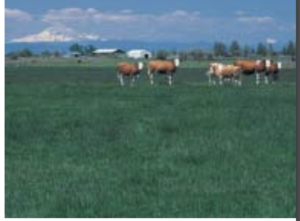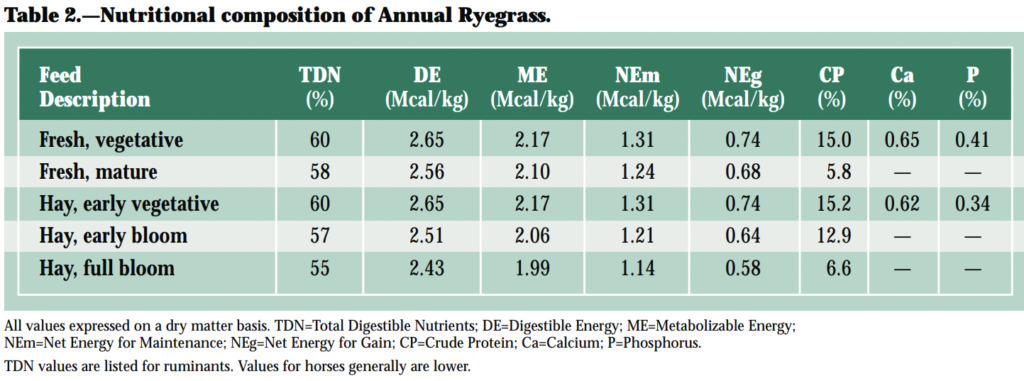Annual & Gulf Annual Ryegrass Uses:
Turf:
• Erosion control, roadsides and reclamation
• General turf and winter overseeding including home lawns, sports fields, golf courses, roadsides, parks and other turf areas
Pasture and Forage:
• Rapid establishment and regrowth for grazing and green chopping
Agricultural Overseeding and Cover Crop Establishment:
• Captures nitrogen
• Helps hold moisture in the soil profile
• Weed suppression
• Kills easily with RoundUp®
Oregon-grown Annual Ryegrass is used for pasture, turf, erosion control and other applications requiring quick, economical ground cover. It is effective for holding soil where wind and water erosion are a hazard.
Annual Ryegrass has an aggressive root system which establishes quickly in poor and compacted soils. Annual Ryegrass is commonly used to seed newly excavated hillsides and as a “nurse” grass along roadsides, berms and in golf course roughs while permanent turf is establishing.
Annual Ryegrass is an economical answer for quick, temporary turf establishment.
In a pasture, Annual Ryegrass will establish in a wide range of soil types and has aggressive regrowth after grazing.
Annual Ryegrass is moderately cold and heat tolerant. Fall plantings will survive mild winters and snow cover. Annual Ryegrass will survive temperatures to 100ºF with adequate water and is sometimes used for winter overseeding warm season grasses to extend the grazing season.
Annual Ryegrass is an important short duration grass. High palatability and digestibility make this species highly valued for forage/livestock systems. It is used in many environments when fast cover or quick feed is required.
Characteristics include:
• High yield potential
• Fast establishment
• Suitable for reduced-tillage renovation
• Compatible with heavy and waterlogged soils
Understanding the Many Uses of Annual & Gulf Annual Ryegrass
There are nearly 3 million acres of Annual & Gulf Annual Ryegrass in the United States, with about 90 percent used for winter pasture in the Southeast. About 80 percent of this ryegrass pasture is established by overseeding into warm season perennial grasses to extend the grazing season.
Annual Ryegrass is also grown for silage and hay on poorly drained soils where small grains are not adapted.
In the Northeast and Pacific Northwest, Annual Ryegrass is used to interseed corn and other row crops to absorb excess nitrogen, reduce erosion after row crop harvest and provide winter feed.
In the northern United States and Canada it is grown as a summer annual, typically as a quick cover lawn grass. Often it serves as a “nurse” crop for the slowergerminating and establishing lawn grass species.
Smaller amounts are used for roadside stabilization, as a cover crop for reducing soil erosion and as a green manure crop to provide organic matter for improved soil structure.
Interestingly, Annual Ryegrass is also used for fish feed in China. Grass-eating species of carp are fed hand-harvested Annual Ryegrass.
Annual & Gulf Annual Turf Applications
Annual Ryegrass is quick to germinate and is often used to overseed the warm-season grasses. The warm-season turf is sometimes mowed lightly to allow the ryegrass seed to get good soil contact, but the seed is often just spread on top of the established turf and watered in.
Annual Ryegrass is lighter green and slightly coarser than perennial ryegrass. It is also less heat-tolerant than perennial. This could be an advantage for overseeding since Annual Ryegrass should disappear before it interferes with the growth of the warm season grass.
Warm season grasses go dormant during the winter months and can be overseeded with a cool season grass variety to maintain green color and adequate quality. Annual Ryegrass, perennial ryegrass or rough bluegrass are the standard grasses used for overseeding.
The best time to overseed the home lawn is mid to late October, but more accurately after the first frost. Annual Ryegrass is the fastest germinating of the three varieties and often the least expensive.
Annual and perennial ryegrass both grow quickly, especially during late fall and early spring. Their water use rates are moderate and fertility requirements are low, maybe one to two pounds of nitrogen over the winter months. You should overseed at a rate of about 10-12 pounds of seed per thousand square feet and keep the lawn irrigated for several weeks to insure germination.
• May be sown under unfavorable wet or dry conditions
• Normally germinates in a matter of 7- 10 days
• If sown under dry conditions, normally germinates after the first solid rain
• Always in excellent supply and competitively priced
• Forage preferred by livestock
• Vigorous fall and spring growth
• Left uncut Annual Ryegrass grows to a height of 2-4 feet
Annual & Gulf Annual Ryegrass in Pastures
Highly Preferred by Livestock
Either Oregon-grown common Annual Ryegrass or Gulf Annual Ryegrass will provide cattlemen with an additional six to eight months of abundant, nutritious pasture which will see a young cow continue to grow and gain while nursing a calf which is also gaining and thrifty.
Annual Ryegrasses may be sown alone or in combination with legumes or small grains.
For decades the Annual Ryegrasses have demonstrated the ability to produce high quality forage which will not go dormant or off color through the chill of winter and remain productive on into the spring.
Normally, Annual Ryegrass germinates in a matter of 7-10 days or even less in ideal conditions. Sowing dates vary according to area. Some growers prefer to winterseed pastures after the first killing frost as a means of eliminating competition from native grasses. Others prefer to sow earlier to give the Ryegrass seedlings an opportunity to flourish while the ground is still warm.
While soil fertility and weather conditions are determining factors, light grazing is often available in about 90 days after sowing.
Some farm operators feel light grazing can begin when the new grass is 4-5 inches high, while others wait for greater growth so that the new plants will not be uprooted by grazing animals.
Because Annual Ryegrass quickly develops a strong root system it helps prevent bogging in moist areas and stabilizes precious topsoil.
Recommended rates of nitrogen application and other fertilizers vary according to soil conditions and the region but, in general, applications of up to 150 pounds per acre at or before planting are desirable.
Here are the Advantages of Oregon-Grown Annual Ryegrass:
• Normally supports a growing cow and calf per acre
• May be sown on existing sod, clean-burned stubble or land not plowed or otherwise prepared
• May be sown under unfavorable wet or dry conditions
• Oregon-grown Annual and Oregon-grown Gulf Annual are considered disease-tolerant
• Does not present endophyte fungus problems as do some tall fescues
• Recovers rapidly from overgrazing and trampling
• Usually germinates in 7-10 days Annual Ryegrass pastures are used for stocker cattle, replacement heifers and lactating dairy cows.
Its strong seedling vigor, high yield and high quality also make it valued for temporary pastures in the coastal Northwest. Although Annual Ryegrass grows quickly and is highly productive, its short-lived and aggressive nature make it less desirable in permanent pasture mixes

Silage and Hay
Annual Ryegrass often is harvested for silage. The high production capacity of this grass makes it popular for additional feed when short hay supplies are expected.
As with all forage species, silage quality is influenced greatly by maturity stage at harvest. For the optimal compromise between quality and quantity, cut Annual Ryegrass in the boot to earlyheading stage.
Harvesting Annual Ryegrass for hay is not recommended in high rainfall/humidity areas such as the coastal Pacific Northwest. Good hay-curing weather typically occurs too late in this region for producing high-quality Annual Ryegrass hay.
Wildlife
Annual Ryegrass is an excellent wildlife feed. Forage provides high-quality grazing and a quick source of energy for geese, coots, widgeons and other ducks, wild turkeys, rabbits, deer and elk.
Annual Ryegrass varieties are grouped into three maturity categories: early, intermediate and late. These groupings are somewhat helpful, but there is substantial overlap among them.

Annual Ryegrass in Cover Crops and Overseeding Programs Offers the Following Benefits
• Captures Residual Nitrogen
• Helps Hold Moisture in the Soil Profile
• Increases Water Infiltration and Soil Moisture Holding Capacity
• Helps Prevent Soil Erosion
• Weed Suppression
• Helps Increase Soil Organic Profile
• Improves Harvest Conditions
• Provides Spring Pasture or Hay
• Kills Easily with RoundUp®
Leaf tissue analyses have shown that through absorption of residual nitrogen Annual Ryegrass can return approximately 11 /2 pounds of nitrogen to the soil for every 100 pounds of dry matter plowed down.
Over time the use of Annual Ryegrass can increase the friability of heavy soils and add bulk to light soils.
When left uncut, Annual Ryegrass normally reaches 2 to 4 feet.
Approximately 70 percent or more of the Annual Ryegrass will be available in the spring after overwintering in either corn or soybeans.
Annual Ryegrass Benefits in Buffer Strips and Grassed Waterways
Buffer strips can be tremendously effective in reducing the runoff of nutrients and pesticides. According to research information compiled by the United States Department of Agriculture, properly installed, well maintained buffers help:
• Reduce nutrient and pesticide runoff into water bodies by 50 percent or more
• Reduce sediment loadings by 75 percent
• Reduce pathogen loadings by 60 percent
In addition to slowing runoff, buffers create havens for many different types of wildlife. Shady areas of a stream created by buffers can lower water temperatures and help increase fish populations.
Annual Ryegrass buffers are visual and tangible examples of land stewardship.
Four Steps To Lush Green Turf:
1. Mow your lawn at the lowest possible setting and remove clippings. Rake lawn with metal-tine rake to remove debris which may have collected at the base of grass plants so that the Ryegrass will be in contact with the soil.
2. Apply (according to instructions on the bag) a balanced fertilizer. “Slow-release” fertilizers are best because they release nutrients gradually as the new grass plants need them but fertilizers recommended by your seed dealer will be satisfactory.
3. Sow Oregon-grown Ryegrass at the rate of 10-15 pounds per 1,000 sq. ft. Heavier seeding rates produce a thicker, greener lawn. Seed is best sown with a drop spreader – which can be purchased or rented – but successful applications may be made with hand-cranked whirlwind spreaders. If a mechanical spreader is not available, seed may be sown by hand. To assure that seeds make contact with the ground, rake the lawn lightly with the back of a rake after the seed has been sown.
4. After sowing the seed, keep the lawn moist so that the new grass plants will develop a strong root system. Frequent light waterings are recommended because heavy watering may create runoff which could unevenly redistribute the seed before it has germinated.
